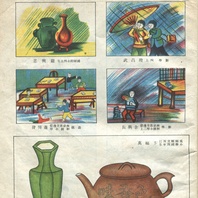
Item
Ertong zuopin (works by children), I
This is a selection of images (most being pencil drawings) contributed to the magazine Ertong huakan (Children’s Pictorial) 9.10 (April 1941) by readers. The images offer a fascinating insight into the ways in which official ideas about perceived notions of student behaviour in occupied China were reflected in the artwork of Chinese school children living in the RNG capital. Two of the drawings in this selection, for example, relate to the hardships of studying (in difficult weather, poor light, etc), while one depicts children playing in a classroom.
Read More
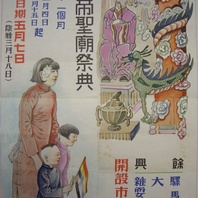
Item
Yaodi shengmiao jidian (Ceremony at the Emperor Yao Temple)
This poster was produced (almost certainly by the Japanese military) with the aim of advertising the re-opening of the Emperor Yao Temple (Yaodi shengmiao) in Linfen (Shanxi Province). This site was taken by the Japanese from communist resistance fighters, and was used by the Japanese as a symbol of the apparent iconoclasm and lack of religious sensitivity shown by the communists. The re-opening the temple to worshippers in the spring of 1938 by the Japanese was used to demonstrate the extent to which occupation supposedly included respect for Chinese religious traditions. The painted image of the female worshipper here was based on a photograph of a female worshipper at the same temple produced in other propaganda leaflets some months earlier.
Read More
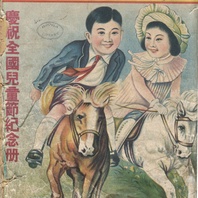
Item
Qiantu wuliang (An immeasurable future)
Cover of a magazine which was published in Nanjing for children themselves during the Japanese occupation. The artist who created this image is not named. Publication details are: Ertong huakan (Children’s Pictorial) 9.10 (April 1941): cover image
Read More
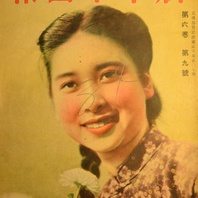
Item
Xin Zhonghua huabao (New China Pictorial) cover, September 1944
This cover image from the Xin Zhonghua huabao (New China Pictorial) 6.9 (September 1944) shows Chen Juanjuan. Chen was a film celebrity active in wartime Shanghai. The New China Pictorial was a bilingual (Chinese-English) magazine published from 1939 through 1944 in Shanghai by the occupation journalist Wu Linzhi for distribution in China and throughout Southeast Asia.
Read More
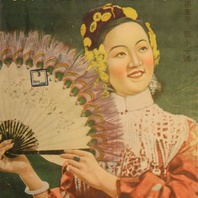
Item
Xin Zhonghua huabao (New China Pictorial) cover, November 1943
This cover image from the Xin Zhonghua huabao (New China Pictorial) 5.11 (November 1943) shows an unattributed painting of the Beijing opera actress Huang Yuhua. Huang starred in Pansi dong (The Cave of the silken web), an opera film produced by the North China Film Company (Huabei Dianying Gongsi) in 1943. The image used here is from promotional material relating to that film. The New China Pictorial was a bilingual (Chinese-English) magazine published from 1939 through 1944 in Shanghai by the occupation journalist Wu Linzhi for distribution in China and throughout Southeast Asia.
Read More
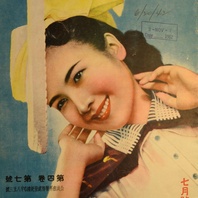
Item
Xin Zhonghua huabao (New China Pictorial) cover, July 1942
This cover image from the Xin Zhonghua huabao (New China Pictorial) 4.7 (July 1942) shows Nancy Chan (Chen Yunshang). Chan was one of the most popular film celebrities in wartime Shanghai, and was favoured by the occupation regime in pro-government media, despite emulating Hollywood stars in terms of her dress and public image. The New China Pictorial was a bilingual (Chinese-English) published from 1939 through 1944 in Shanghai by the occupation journalist Wu Linzhi for distribution in China and throughout Southeast Asia.
Read More
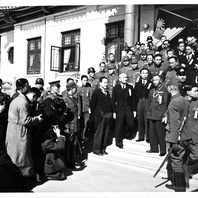
Item
RNG leaders on steps of Government Headquarters, November 1940
Flanked by civilian and military staff, Wang Jingwei, Zang Shiyi (the Manchukuo ambassador to the RNG) and Chu Minyi (RNG foreign minister) pose for photographs in front of the ceremonial hall (litang) in the national government compound in Nanjing after the signing of the Japan-Manchukuo-China Joint Declaration on 30 November 1940, through which RNG China recognised Manchukuo.
Read More
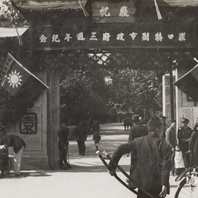
Item
Park in Wuhan, spring 1943
Photograph of a park in Wuhan festooned to “Celebrate the 3rd anniversary of the founding of the Hankou Municipal Government” (Qingzhu Hankou tebie shi zhengfu san zhounian jinian). While Wuhan is often remembered as a centre of anti-Japanese resistance in the early war years, it was also incorporated into the RNG realm in 1940, and became a major political and cultural centre for that administration. Interestingly, the ROC flag shown here still includes the RNG pennant (which read “peace, anti-communism, and nation building”, and which had been added to the flag in 1940), even though Chinese authorities in occupied areas were, from January 1943 onwards, not obliged to include this pennant.
Read More
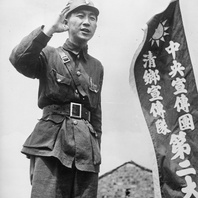
Item
Rural Pacification cadre making a speech
Photograph of a member of the RNG Central Propaganda Group’s Number 2 Rural Pacification Propaganda Team as he addresses a rural audience. The photograph was possibly produced by the RNG’s Central News Agency, which increased its capacity for photography in 1942 to compete with the propaganda work of Chiang Kai-shek’s Nationalists in Chongqing.
Read More
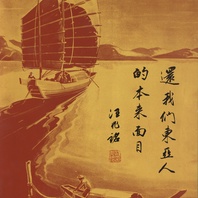
Item
Huan women Dong Ya ren benlai de mianmu (Restore to we East Asians our original countenance)
This unattributed print was produced in a special 1941 booklet commemorating Wang Jingwei’s visit to Japan in June of that year. The phrase “Huan wo Dong Ya ren benlai de mianmu” (Restore to we East Asians our original countenance) is a deliberate play on the expression “Huan wo heshan” (Return to us the rivers and mountains). The latter was probably the single most commonly used phrase in the wartime propaganda of the resistance. The print is taken from Huang Qingshu (ed), Wang zhuxi fang Ri jinian huakan (Special pictorial in commemoration of Chairman Wang’s visit to Japan) (Nanjing: Xuanchuanbu, 1941).
Read More
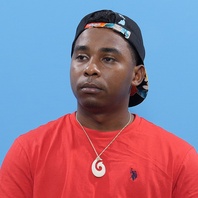
Essay
Bodies of Occupation: Conversation with Khvay Samnang and Vuth Lyno
This conversation with artists Khvay Samnang and Vuth Lyno will explore different forms of corporeal occupation, resistance and transformation in Cambodia (including political violence, extractivism and international justice). Vuth Lyno, 25 (2018), courtesy of the artist. Participants Pamela Nguyen Corey researches and teaches modern and contemporary art history, focusing on Southeast Asia within broader transnational Asian and global contexts. She received her BA (Studio Art) from the University of California, Irvine, and her PhD (History of Art and Visual Studies) from Cornell University. She will join Fulbright University Vietnam in January 2021 from SOAS University of London, where she has been teaching since receiving her PhD in 2015. She is the author of The City in Time: Contemporary Art and Urban Form in Vietnam and Cambodia (University of Washington Press, 2021), and her writing is featured in numerous academic journals, exhibition catalogues, and platforms for artistic and cultural commentary. She is a guest co-editor of “Voice as Form”, a special issue of Oxford Art Journal (2020), which introduces material from her new research into the use of voice and sound in contemporary artworks from Southeast Asia and its diasporas. Her research has been supported by the Fulbright-Hays Program and the Center for Khmer Studies, and most recently by the British Academy for a Newton Mobility Grant project entitled “Constructing Decolonial Art Histories of Southeast Asia” in collaboration with the University of Malaya. Khvay Samnang (b. 1982, Svay Rieng) graduated from the Painting Department at the Royal University of Fine Art in Phnom Penh, where he lives and works today. Khvay’s multidisciplinary practice offers new views on historic and current events as well as on traditional cultural rituals using humorous symbolic gestures. In his work, which includes all media, he focuses on the humanitarian and ecological impacts of colonialism and globalization. The development of each body of work is based on thorough research and investigation of local specificities, structures and conditions. Khvay is a founding member of Stiev Selapak, an art collective dedicated to reappraising and remembering Cambodian history and exploring continuities in visual practices disrupted by civil war and the Khmer Rouge regime. In 2010-11, Stiev Selapak set up two nonprofit art spaces in Phnom Penh: Sa Sa Art Projects, for experimental residencies, knowledge-sharing and community-based programmes; and SA SA BASSAC – a gallery, resource centre and reading room. Khvay teaches Contemporary Art Class to emerging Cambodian artists under the programme of Sa Sa Art Projects. In 2016 he was nominated for the Future Generation Art Prize, Ukraine. In 2015 he was nominated for Prix Pictet Prize; AIGA AGO Photography Prize Long List, Canada; the Sovereign Asian Art Prize, Hong Kong; and Prudential Eye Awards Best Emerging Artist in Asia Using Photography, Singapore. In 2014-15 he was a grant holder of KfW Stiftung for the 12-month programme “Artists in Residence” in collaboration with Künstlerhaus Bethanien, Berlin. In 2017 he was invited by KfW Stiftung as an alumnus to participate in a think tank with the world-renowned dancer and choreographer Akram Khan. In 2019 he was artist in residence at Delfina Foundation, London. Khvay has exhibited at numerous art centres, biennales and galleries worldwide, including Haus der Kunst in Munich, Orange County Museum of Art in California, Künstlerhaus Bethanien in Berlin, Jeu de Paume in Paris, CAPC in Bordeaux, Asia Pacific Triennial of Contemporary Art, Taipei Fine Arts Museum in Taiwan, DOCUMENTA 14, Jim Thompson Art Center in Bangkok, Biennale of Sydney, Kadist Foundation in San Francisco, Singapore Biennale, and ZKM | Center of Art and Media in Karlsruhe (his website). Annie Jael Kwan is an independent curator and researcher whose exhibition-making, programming, publication and teaching practice is located at the intersection of contemporary art, art history and cultural activism, with interest in archives, histories, feminist, queer and alternative knowledges, collective practices, and solidarity. As co-director of Something Human, a curatorial initiative, she has presented live art projects across the UK and Europe, and launched the the pioneering Southeast Asia Performance Collection (SAPC)with over 27000 digital items that represent 50 artists from the region at the Live Art Development Agency during the 2017 M.A.P. (Movement x Archive x Performance) project. In 2018, she curated the exhibition and public programme, UnAuthorised Medium, that explored artistic responses to the “archive” featuring thirteen artists working in relation to Southeast Asia at Framer Framed, Netherlands. In 2019, she co-curated the Archive-in-Residence “Southeast Asia Performance Collection” exhibition, along with the Pathways of Performativity in Contemporary Southeast Asian Art conference at the Haus der Kunst in Munich, Germany. Kwan leads Asia-Art-Activism (AAA), an interdisciplinary, intergenerational research network that has been in residence at Raven Row since 2018. In 2019, she curated the live art programme, Being Present, at the Manchester Art Gallery, and its digital adaption for the Paul Mellon Centre’s British Art Studies Issue 13; in 2020, she led and co-curated the expansive digital programme, Till We Meet Again IRL, and in 2021, launched Tools to Transform (co-initiated with Joon Lynn Goh), a project focused on creating resources for Asian and diaspora organising that received the European Cultural Foundation’s Culture of Solidarity grant in 2020. For the 2021 London, Asia, Art, Worlds conference convened by the Paul Mellon Centre’s Studies in British Art, she curated the online programme, QueerAsias, and was part of the curatorial committee for the Korean Cultural Centre UK’s A Screening Room. She is the instigating council member of Asia Forum, along with Hammad Nasar, Dr Ming Tiampo and John Tain, that was launched on 14 May with a programme featuring Patrick Flores, Ho Tzu Nyen, Anna Tsing, Lantian Xie and Shilpa Gupta. Asia Forum is scheduled for a digital gathering in October 2021, and a one-day programme at the Venice Biennale on 23 April 2022 at the Fondazione Querini Stampalia. She was the co-editor of Southeast of Now: Directions in Contemporary and Modern Art in Asia’s guest issue: Archives. She is a recipient of a Diverse Actions Leadership Award 2019, and currently teaches Critical Studies at Central St Martins, University of the Arts, London, and co-teaches Writing and Curating at KASK, School of Art, in Ghent, Belgium. Vuth Lyno (b. 1982, Phnom Penh) is an artist, curator and educator interested in space, cultural history and knowledge production. His artworks often engage with micro and overlooked histories, notions of community, place-making, and production of social relations. He works across various media, including photography, video, sculpture, light, and sound. He often constructs architectural bodies as situations for interaction. He introduces human stories and knowledge within these installations by drawing on a wide range of materials such as original interviews, artifacts, and newly made objects. His artistic and curatorial practice is participatory in nature, engaging mutual and communal learning, experimentation, and aims to share multiple voices in the production of meaning. He believes in the potency of collectivity, storytelling, and the agency of cultural objects as potential pathways to reimage our sociality. Alongside his individual artistic practice, he is also a member of Stiev Selapak collective which founded and co-runs Sa Sa Art Projects, a long-term initiative committed to the development of contemporary visual arts landscape in Cambodia. Together with the collective, he teaches, initiates, and innovates art programs facilitating a growing and more critically conscious community. Vuth has presented his artworks in Cambodian and international venues, including at major exhibitions and festivals such as the Asia Pacific Triennial of Contemporary Art, Biennale of Sydney, Singapore International Festival of Arts, and Gwangju Biennale. His artworks have appeared at institutions such as the Museum of Contemporary Art Taipei; Gallery of Modern Art, Brisbane; Metropolitan Museum of Manila; the Art Gallery of New South Wales, Sydney; the National Gallery of Indonesia, Jakarta; Centre for Contemporary Art Ujazdowski Castle, Warsaw; Guangdong Times Museum, Guangzhou; Osage Gallery, Hong Kong; and Chiang Mai City Arts & Cultural Centre. He holds a Master of Art History from the State University of New York, Binghamton, New York, a Fulbright Fellowship (2013-2015), and a Master of International Development from RMIT University, Melbourne, supported by the Australian Endeavour Award (2008-2009) (his website).
Read More
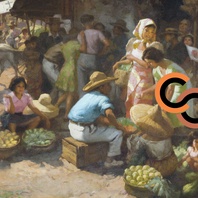
Page
COTCA
Cultures of Occupation in Twentieth Century Asia (COTCA) is a European Research Council-supported project (funded under the European Union’s Horizon 2020 Research and Innovation Programme: Grant Number 682081) which explores how foreign occupation, in various forms, has influenced cultural expression in East and Southeast Asia in the modern era. This site is home to COTCA’s Digital Archive. The archive holds primary source materials collected in various archives and libraries around the world, and organised according to case studies undertaken under the COTCA Project. The three case studies which are currently “live” are (i) Japanese-occupied China; (ii) the Malayan Emergency and (iii) the Spatial Politics of Identity in Cambodia. Follow the links below to these case studies. Data from other case studies will be uploaded in due course. We will also be adding multi-language functions to the site in the near future.